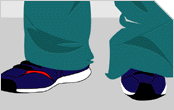

Borax may prove useful in a lot more than laundry detergent. DaimlerChrysler engineers believe a variant of the innocuous white powder provides a safe, compact way to contain hydrogen. The lack of such storage for the notoriously flammable gas has been a key obstacle to the development of fuel-cell-powered cars. Borax’s first performance is in a concept minivan called the Chrysler Town & Country Natrium (Latin for sodium, an element in borax).
A fairly simple chemical process joins borax and hydrogen in a manner that renders the gas nonflammable. When mixed with water in the Natrium’s fuel system, this sodium borohydride powder produces free hydrogen for the fuel cell (see chart). Unlike other alternative fuel systems, such as those using methanol and gasoline, the Natrium produces no pollution and no carbon dioxide.
Better yet, the powder holds more hydrogen than the most densely compressed air tank. The prototype van can drive 300 miles on a tank of fuel-much farther than the typical fuel cell vehicle. The same tank of hydrogen compressed by conventional means would fill most of the van’s cargo area.
The by-products of this process are water and sodium borate-basically the same stuff as in soap. After use, the spent powder goes into a storage tank. DaimlerChrysler envisions gas station pumps that would exchange sodium borohydride for spent sodium borate. Tankers would resupply stations with the hydrogen-carrying powder and return the used stuff to the refinery.
Hydrogen would be added in a chemical plant. And in a pinch, says Tom Moore, vice president of technical affairs, “You could wash your hands with the residue.”












